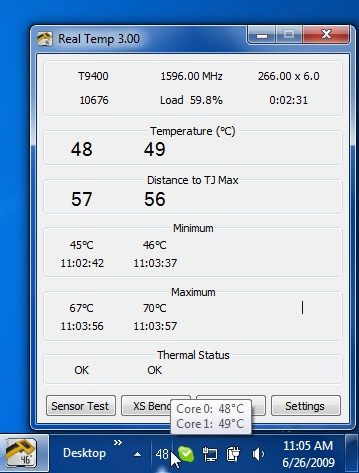
- #LAPTOP TEMP MONITOR WINDOWS 10 IN DEGREES HOW TO#
- #LAPTOP TEMP MONITOR WINDOWS 10 IN DEGREES DRIVERS#
- #LAPTOP TEMP MONITOR WINDOWS 10 IN DEGREES UPDATE#
- #LAPTOP TEMP MONITOR WINDOWS 10 IN DEGREES SOFTWARE#
- #LAPTOP TEMP MONITOR WINDOWS 10 IN DEGREES PC#
In addition, you may also run the Intel® System Support Utility (Intel® SSU) to gather more details about the system. To upload and attach the file, use the " Drag and drop here or browse files to attach" option below the response textbox. To save the report, once the test is done, click on " File > View Results File" and save on the computer the. Sure, you can upload the results report of the Intel® Processor Diagnostic Tool in the thread.
#LAPTOP TEMP MONITOR WINDOWS 10 IN DEGREES HOW TO#
How to roll back the BIOS on a third-party system is out of our scope of support and we are neither able to guarantee if that is possible/safe nor we handle the recommended steps for that task.

Since your OEM ASUS* is the one that is familiar with their BIOS design, we recommend addressing this inquiry to them since they are the proper channel of support and they should provide proper steps to avoid issues or mistakes.
#LAPTOP TEMP MONITOR WINDOWS 10 IN DEGREES PC#
Depending on the OEM, PC model, the changes/updates involved in a BIOS update, security concerns, etc., a BIOS downgrade may not be recommended or even not allowed. Regarding your inquiries:įor question #1 " How to roll back the BIOS to the one that was the first?"Įach computer manufacturer (OEM) designs and develops its own BIOS, features, and customizations. Your OEM is the one that is familiar with their BIOS design, features, and thermal solution, so they would be the best channel of support. Please note that every OEM may design the BIOS with specific features or limitations. If the processor is unable to maintain a safe operating temperature through throttling actions or if high temperatures are affecting system performance, we highly recommend checking this further with ASUS* support team regarding availability, possibility, and support for features or options to perform changes on their BIOS to adjust system performance and thermal control so they may provide additional debugging and diagnostic from their end. Usually, there are BIOS sensors and controls that regulate its behavior based on processor/system temperature. The design and integration of the cooling solution is something specific to the laptop manufacturer (OEM). The throttle temperature can vary depending on the processor, BIOS settings, thermal solution, and overall system integration and design. We recommend using the system with the default settings in the BIOS recommended by the computer manufacturer (OEM) ASUS*.
#LAPTOP TEMP MONITOR WINDOWS 10 IN DEGREES SOFTWARE#
We would like to clarify that a user should not need to change parameters about CPU frequency or voltage, neither on the BIOS nor via software running the processor using BIOS defaults should be enough to use the processor under normal conditions.Īctually, altering clock frequency or voltage may damage or reduce the useful life of the processor and other system components, and may reduce system stability and performance.
#LAPTOP TEMP MONITOR WINDOWS 10 IN DEGREES DRIVERS#
We tried to check for drivers and BIOS available for your system, but using the model number provided ( ASUS* Rog Strix Scar 17 G732LV-EVO52) we are not sure if the one we found refers to your specific system, so we recommend checking with ASUS* support for the proper drivers/firmware. The purpose of the Intel® Processor Diagnostic Tool is to verify the functionality of an Intel® microprocessor.
#LAPTOP TEMP MONITOR WINDOWS 10 IN DEGREES UPDATE#
Note: You may wish to note the current BIOS settings before resetting the BIOS.ĥ- Check with ASUS* if a BIOS update is available and if they recommend updating the BIOS.Ħ- Test the processor with the Intel® Processor Diagnostic Tool. Undo any recent changes that might have caused the overheating problem.Ģ- Check to make sure that the intake vents and exhaust vents are clear of dust and lint and nothing is blocking proper airflow.ģ- Make sure your system is up to date (Windows updates, drivers, and software updates).Ĥ- Try to load the default BIOS settings in your system. Here are some recommendations that you may review and try to improve thermal control and to verify the processor is operating fine:ġ- See if anything has changed around the system. Intel processors constantly monitor their temperature and can very rapidly adjust their frequency and power consumption to prevent overheating and damage. Being at maximum temperature while running a workload isn't necessarily cause for concern. In sustained workloads, it's possible the processor will operate at or near its maximum temperature limit.

The Intel® Core™ i7-10875H Processor has a Junction Temperature (the maximum temperature allowed at the processor die) of 100☌. Hello you for posting on the Intel® communities.


 0 kommentar(er)
0 kommentar(er)
